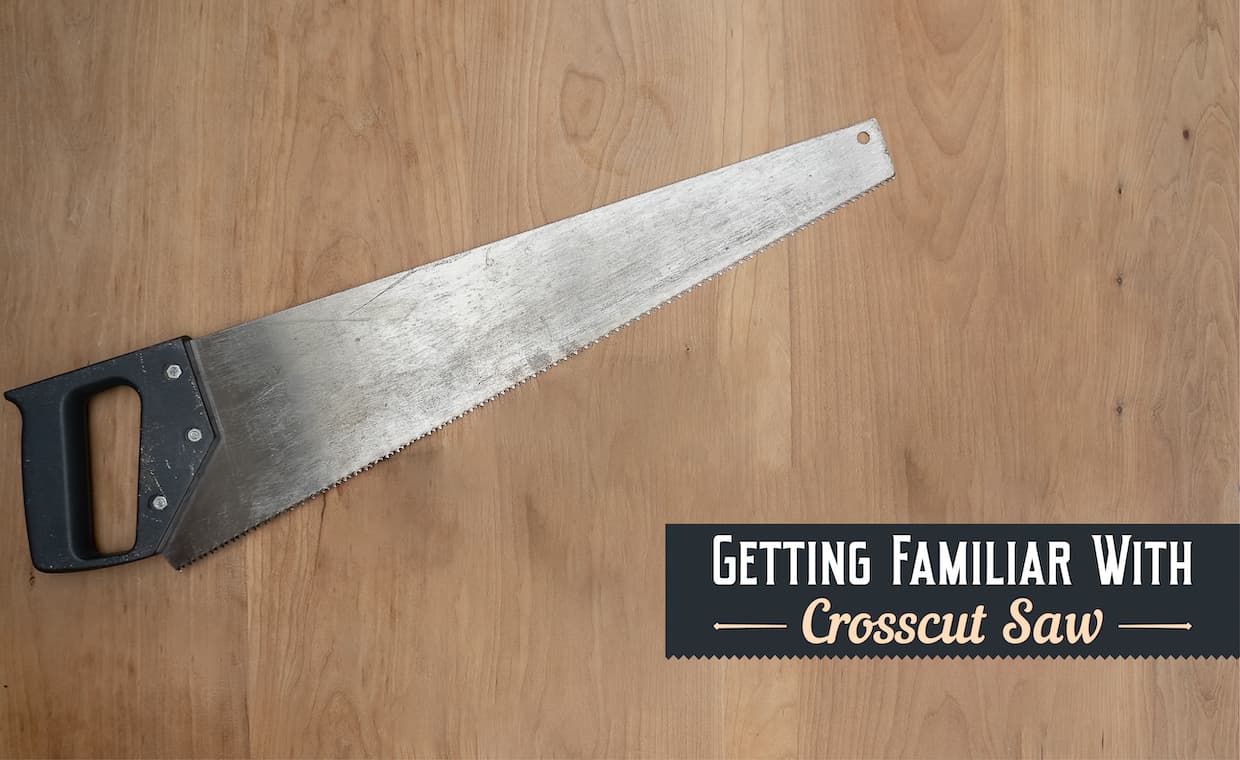
Table of Contents
Quick Summary
- A Crosscut saw is an essential tool for clean wood-cutting tasks.
- It cuts wood across the grain smoothly and efficiently.
- Crosscut saws come in one-person and two-person types.
- One-person saws have D-handles and support holes.
- Two-person saws have vertical handles for shared pulling.
- Saw teeth are alternately set for smooth slicing action.
- Some models include rakers for cleaner cutting results.
- Regular cleaning prevents rust and pitch buildup.
- Use citrus cleaners or naval jelly when needed.
- Always store saws hanging, never flat or leaning.
- Apply oil before storage to avoid rust formation.
- Use sheaths for protection during use and travel.
Crosscut saw is a carpentry equipment and required in almost all the clean-cutting woodwork. If you’ve special nose about wood work, information about a crosscut saw will be interesting for you.
Woodworking as a hobby is an excellent choice. It can improve your skills in time management, project management, layout creation, problem-solving, attention to detail, and planning. But for gaining mastery in woodworking, you must be familiar with different tools and equipment: a crosscut saw is one of them. The tool will keep you ahead of the curve in many wood work project with faster turnaround time.

Crosscut saws are one of the most-in-use tools in woodworking. It allows you to cut wood, such as plywood and planks, in one straight direction. If you don’t have one yet, visit Pacific Trail Manufacturing or your local hardware shops.
However, crosscut saws can bring the risk of injury if you don’t know how to use them. Nevertheless, this article will discuss about the tool and many other related information to help you to handle and work with crosscut saws safely. Keep on reading to develop advanced insights about this tool and tips to work with it.
What is a Crosscut Saw?
A crosscut saw is a type of saw developed to create a crosscutting action. It’s designed to cut wood across the direction of or perpendicular to its grain. If you’re cutting down a tree, it’d be best to use a crosscut saw for a smoother cut.
In addition, crosscut saws are either equipped with a small or large set of teeth. Small teeth are used to create fine and detailed cuts, while large teeth are used for chopping down huge wood pieces, such as trees and logs of wood.
Also, a crosscut saw can be a handheld or a power tool. Some crosscut saws are huge enough to be operated using a machine to chop down objects several feet thick. If you’re interested in this kind of crosscut saw, check out this video – Click Here.
How The Crosscut Saw Works
The teeth or the cutting edge of a crosscut saw are positioned alternately. This teeth alignment allows the saw to act like a knife slicing through a loaf of bread. It’s the opposite of a rip saw that creates tears across the grain like a microscopic chisel.
Meanwhile, some crosscut saws use rakers. It’s a specially developed set of teeth that lets you create a much cleaner crosscutting action. Furthermore, the teeth of a crosscut saw are much smaller than those of the rip saw. On the other hand, to protect yourself from these razor-sharp teeth, create a list of safety precautions and check each box as each one is met. Also, what is Crosscut Saw Used for?
Crosscut saw is used for cutting a wood across the grain. They are used to cut wood logs, plywood, large timber logs, trees for timber, wood boards, joists and all other wood work.
Types Of Crosscut Saws
Crosscut saws are divided into two different types: one-person and two-person crosscut saws.
1. One-Person Crosscut Saws
A one-person crosscut hand saw is similar to your basic handsaw. It has a D-shaped handle and a hole at the blade’s tip. That hole is reserved for supplementary handles to provide support while cutting planks and logs of wood. Typically, the size of a one-person crosscut hand saw is between three and five feet long.

2. Two-Person Crosscut Saws
A two-person crosscut saw is like two one-person crosscut saws merged into one. It’s designed to be used by two people pulling each stroke and its two handles are different. Instead of being D-shaped, its handles are similar to the supplementary handle of a one-person crosscut saw. They’re vertically placed on both ends, allowing the users to pull the saw easily.

Meanwhile, the cutting edge of a two-person crosscut saw can be categorized into three different shapes: flat ground, crescent taper, and straight taper. However, modern types are mostly flat ground—a slightly curved blade similar to a ‘mezzaluna’ knife in Italy but much longer. The typical size of a two-person crosscut saw is typically between four and seven feet long.
Cleaning Your Crosscut Saws
It’s always important to clean your crosscut saw regularly to function effectively. It would be best to clean it after every use before storing it. Leaving the dirt for a long time may cause dull blades and produce rust that can weaken the integrity of your saw.
Here are some tips when cleaning your crosscut saw:
1. Removing Rust
Rust can do more damage to your saw than you think. Over time, it can cause the blades to become brittle and break. Meanwhile, the process of removing rust will depend on its size. Small rust may only require simple scrub with steel wool.
However, if the rust is too heavy to remove, you might need to scrub it using a pumice block. If the rust is extremely heavy for pumice blocks, you may consider using an axe stone.
When removing rust from your crosscut saw, applying a generous cleaning solution is best to keep its pores open. Plus, this will help prevent causing more damage to your saw.
2. Getting Rid Of Pitch Deposits
If you take care of your crosscut saw properly, it’ll never produce rust. But it’ll produce pitch deposits due to regular use. Fortunately, getting rid of them is simple and easy. Lighter deposits can be removed using a citric acid cleaning solution.
However, if buildups are too heavy to remove, you may consider scrubbing them using steel wool with a cleaning solvent.
3. Using Cleaning Agents
As much as possible, avoid using harsh cleaning agents, and make sure to wear protective gear when cleaning your crosscut saws. In this way, you’ll be able to protect yourself from potentially hazardous chemicals that can cause unwanted reactions to your health.
Instead of using harsh cleaning agents, you can use citrus-based solvents. The acid in these solutions will help gently remove rust and pitch deposits without damaging the blade.
Aside from citrus-based solvents, you can also use naval jelly. This is most effective when removing rust and scale deposits. Plus, it prevents the chemical reaction responsible for the formation of rust and scale. However, only use it when necessary and when there’s proper ventilation.
Proper Storage Of The Crosscut Saws
Proper storage is important to maintain and ensure the integrity of your crosscut saws in the long run. In that case, below are some useful tips for storing them correctly.

- Storing your crosscut saws on flat surfaces is a big no-no. Some objects may be dropped on them, resulting in damage. Instead, keep them hanging through a nail on the wall.
- Polish your crosscut saws with canola oil or other eco-friendly lubricants before you store them. Also, wear gloves to protect your hands from their crosscut blades.
- Avoid leaning your crosscut saws on the wall. This will only cause their blades to bend slowly over time.
- Never store your crosscut saws with a cover on them. Storing them with a sheath may trap moisture that can cause rust buildups.
- Never store your crosscut saws in a location where humans or animals may get severely injured by their sharp teeth.
- Don’t put one saw on top of the other. This will cause friction between the two metals, resulting in damage.
Use Sheaths To Protect Your Crosscut Saws
Saw sheaths are highly recommended when using a saw. This will help protect the saw from potential damage. It also minimizes the risk of other people getting injured accidentally. Moreover, it’s best to wear gloves when you try to replace or remove them.
One of the best sheaths you can use for your crosscut saw is an old firehose. All you need to do is to split the hose. Then, apply oil or any water-repelling lubricant along the insides of your hose to reduce the likelihood of rust buildups.
How to Properly Transport Your Crosscut Saws
One of the challenges of owning a crosscut saw is transporting them from one place to another. This is quite difficult because they’re long and sharp. So, what should you do?
Here are some tips that will help you transport your crosscut saws safely and efficiently:
- Always put sheaths on your crosscut saws for additional protection and to prevent causing damage to others.
- When riding a boat, make sure to coat your saws with oil or water-repelling lubricant. This will help prevent splashing seawater from causing rust buildups to your crosscut saws.
- When using a personal car for transportation, make sure that there are no heavy objects on top of your saws that can cause damage over time.
- When hiking to reach your work location, ensure that the last one in line gets it. Avoid carrying your crosscut saws with their blades pointing upward. Also, throw away your crosscut saws immediately when something gets wrong, such as a slip or fall.
- When riding an airplane, be sure to remove the saw handles and roll your saw up.
Final Words
A crosscut saw is one tool to promote simple yet clean and effective wood cutting practices. However, using one can be extremely dangerous, especially for beginners. Hence, wear protective equipment or similar tools for added protection whenever you use your crosscut saw. In addition, consider the tips above for proper crosscut saw maintenance to help improve its lifespan.
To know more about basic equipment for your house, read the below article.
4 Basic Power Tools that are Must for Every Houses !
FAQs on Crosscut Saws
1. What Is the Primary Purpose of a Crosscut Saw?
A crosscut saw is used to cut wood across the grain. It creates smooth, clean cuts on planks, logs, and boards, making it essential for most woodworking tasks.
2. How A Crosscut Saw Is Different from A Rip Saw?
A crosscut saw slices wood fibres with its alternating teeth, while a rip saw tears along the grain. The feature makes crosscut saws ideal tools for smooth perpendicular cuts on various wood pieces.
3. How Often Should You Clean a Crosscut Saw?
Clean your crosscut saw after every use. Removing rust, pitch, and dust helps maintain the blade’s sharpness, prevents damage, and extends its lifespan over time.
4. What Are the Safety Tips Beginners Should Follow When Using a Crosscut Saw?
Beginners should wear gloves, eye protection, and stable footwear. Secure the wood properly, maintain a firm grip, use smooth strokes, and follow basic handling precautions to reduce injury risks.
5. How Should You Store a Crosscut Saw Appropriately?
Store the saw hanging on a wall, never flat, or try leaning against it. Apply a thin oil coat, avoid covers that trap moisture, and keep the saw away from areas where injuries may occur.






























